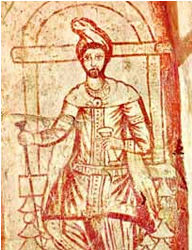 |
The
prophet Zarathustra Papyrus drawing |
Zoroastrians and Parsees celebrate the birth of their prophet Zarathustra on Khordad Sal, the date of which varies, depending on which of the three religious calendars is observed: Fasli, Qadimi or Shenshai.*
The date and place of the prophet’s birth are uncertain, however it seems likely that he lived between 628 and 551 BCE. Some accounts place his birth in western Iran, perhaps near Tehran, however based on the dialect of his poetry, it seems likely that he was born in the east.
Legend says that when his mother was five months pregnant, she had a nightmare about the ending of the world. But then an angel appeared to her, and told her that her unborn child would become a great prophet who would be able to reverse the impending destruction.
It is said that his face was shining at the moment of his birth, and that it is on account of this that he was named Zarathustra, which according to one translation means ‘golden (zara) light (ushas)’; according to another it means ‘yellow (zara) camel (ushtra)’, a translation perhaps more in keeping with the pastoral society into which he was born.
The royal family and the upper classes of Iran used to observe Khordad Sal as Navroz-I-Khas, ‘special new year’s day’, as it was said to be the day on which several historic events occurred. Later, however, these other associations were forgotten, and now the festival is seen solely in terms of the celebration of the prophet’s birthday.
It is a day of rejoicing, when Zoroastrians and Parsees go to fire temples to pay homage and offer prayers. A feast is prepared, and Parsees in India decorate their homes with flowers and rangoli.** Since the Parsee community is especially tight-knit, Khordad Sal is an occasion for gathering together; it is also seen as an opportunity for individual believers to review their lives and make resolutions for the future.**Symbolic decorations painted or chalked on the floor.